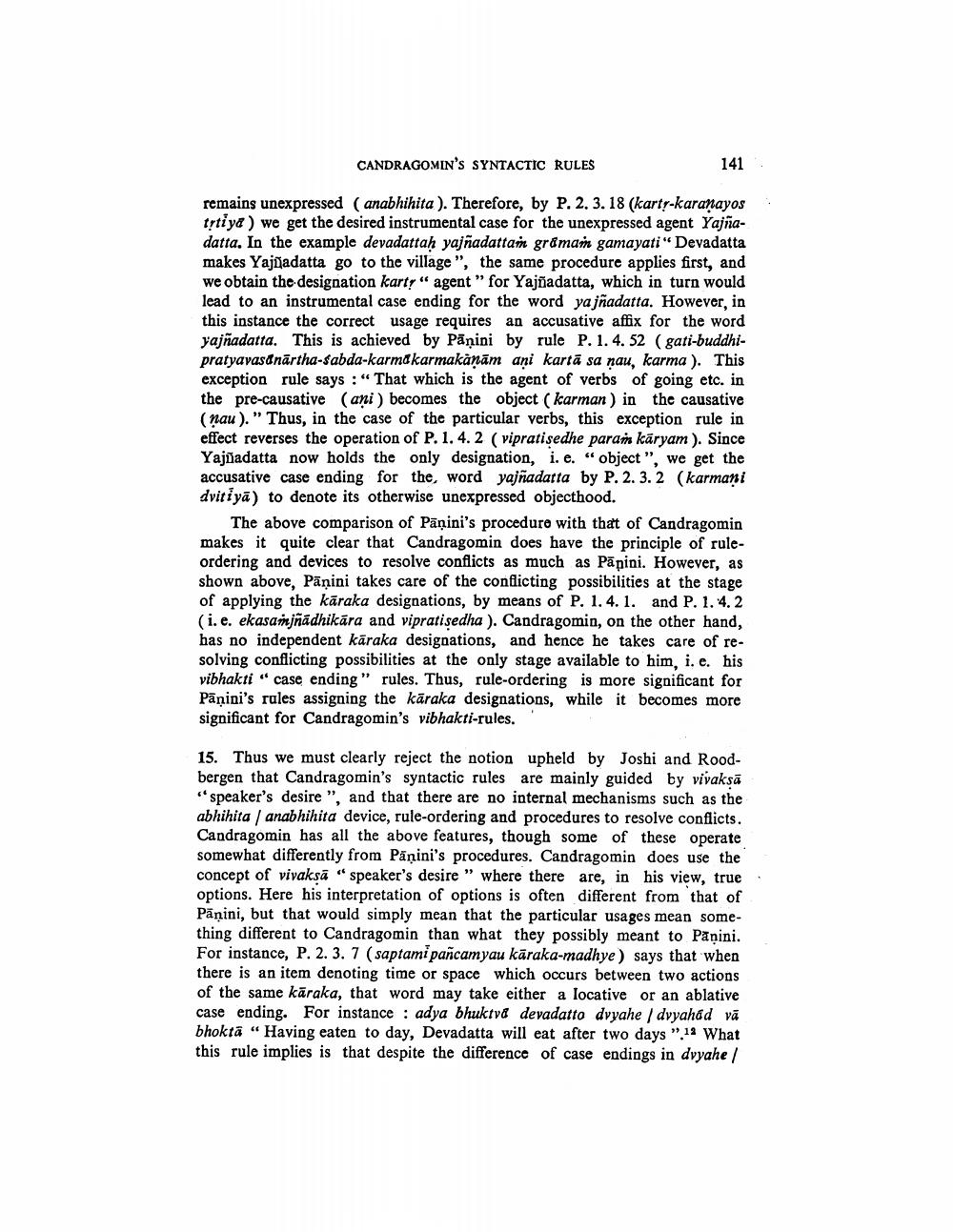Book Title: Candragomins Syntactic Rules Some Misconceptions Author(s): Mahadev Deshpande Publisher: Mahadev Deshpande View full book textPage 9
________________ 141 CANDRAGOMIN'S SYNTACTIC RULES remains unexpressed (anabhihita). Therefore, by P. 2. 3. 18 (karty-karanayos tṛtiya) we get the desired instrumental case for the unexpressed agent Yajnadatta. In the example devadattaḥ yajñadattaṁ gramam gamayati" Devadatta makes Yajñadatta go to the village", the same procedure applies first, and we obtain the designation karty "agent" for Yajñadatta, which in turn would lead to an instrumental case ending for the word yajñadatta. However, in this instance the correct usage requires an accusative affix for the word yajñadatta. This is achieved by Panini by rule P. 1. 4. 52 (gati-buddhipratyavasanartha-sabda-karma karmakaṇām aṇi kartā sa nau, karma). This exception rule says: "That which is the agent of verbs of going etc. in the pre-causative (ani) becomes the object (karman) in the causative (nau)." Thus, in the case of the particular verbs, this exception rule in effect reverses the operation of P. 1. 4. 2 (vipratiṣedhe param karyam). Since Yajñadatta now holds the only designation, i. e. "object", we get the accusative case ending for the, word yajñadatta by P. 2.3.2 (karmani dvitiya) to denote its otherwise unexpressed objecthood. The above comparison of Panini's procedure with that of Candragomin makes it quite clear that Candragomin does have the principle of ruleordering and devices to resolve conflicts as much as Papini. However, as shown above, Panini takes care of the conflicting possibilities at the stage of applying the karaka designations, by means of P. 1. 4. 1. and P. 1. 4. 2 (i.e. ekasamjñādhikara and vipratiṣedha). Candragomin, on the other hand, has no independent karaka designations, and hence he takes care of resolving conflicting possibilities at the only stage available to him, i. e. his vibhakti "case ending" rules. Thus, rule-ordering is more significant for Panini's rules assigning the karaka designations, while it becomes more significant for Candragomin's vibhakti-rules. 15. Thus we must clearly reject the notion upheld by Joshi and Roodbergen that Candragomin's syntactic rules are mainly guided by vivaksā "speaker's desire", and that there are no internal mechanisms such as the abhihita/anabhihita device, rule-ordering and procedures to resolve conflicts. Candragomin has all the above features, though some of these operate somewhat differently from Panini's procedures. Candragomin does use the concept of vivakṣā "speaker's desire" where there are, in his view, true options. Here his interpretation of options is often different from that of Panini, but that would simply mean that the particular usages mean something different to Candragomin than what they possibly meant to Panini. For instance, P. 2. 3. 7 (saptami pañcamyau karaka-madhye) says that when there is an item denoting time or space which occurs between two actions of the same karaka, that word may take either a locative or an ablative case ending. For instance: adya bhuktva devadatto dvyahe | dvyahad vā bhokta "Having eaten to day, Devadatta will eat after two days "12 What this rule implies is that despite the difference of case endings in dvyahe |Page Navigation
1 ... 7 8 9 10 11 12 13
